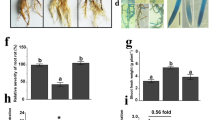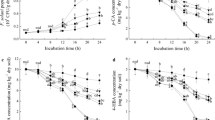Abstract
Root exudates have a key role in communication between plants and microbes in the rhizosphere. Fusarium wilt of watermelon, caused by Fusarium oxysporum f. sp. niveum (Fusarium oxysporum), drastically reduces watermelon yields in continuous cultivation systems, but it can be significantly alleviated using watermelon/aerobic rice intercropping system as shown by the research carried out in this laboratory. It is important to evaluate the interaction between root exudates from the two crops and the pathogen and thus to clarify the mechanism of disease suppressiveness in the intercropping system. The effects of phenolic acids, sugars and free amino acids in root exudates from watermelon (REW) and rice (RER) on the growth of Fusarium oxysporum were studied. The results obtained are listed as follows: (1) REW significantly increased spore germination and sporulation, whereas RER had inhibitory effects on those two parameters. (2) HPLC analysis showed that salicylic acid, p-hydroxybenzoic acid and phthalic acid were identified in exudates from both plants, but p-coumaric acid was only detected in rice and ferulic acid only in watermelon. Moreover, of the total rice exudates a high proportion (37.9 %) of p-coumaric acid was detected and the total amount of phenolic acids was 1.4-fold as high as that in watermelon. (3) Considerable differences in the components and contents of both sugars and amino acids were found between REW and RER exudates. (4) Exogenously applied alanine (Ala) increased spore germination and sporulation. In contrast, addition of exogenous p-coumaric acid reduced spore germination and sporulation, relative to controls. It was concluded that the rice root exudates had anti-fungal properties while that from watermelon promoted pathogen growth. This discovery provided a scientific basis for practicing watermelon/aerobic rice intercropping to control Fusarium wilt in watermelon.







Similar content being viewed by others
References
Anaya AL (1999) Allelopathy as a tool in the management of biotic resources in agroecosystems. Crit Rev Plant Sci 18:697–739
Bais HP, Walker TS, Schweizer HP, Vivanco JM (2002) Root specific elicitation and antimicrobial activity of rosmarinic acid in hairy root cultures of sweet basil (Ocimum basilicum L.). Plant Physiol Biochem 40:9837
Bais HP, Fall R, Vivanco JM (2004a) Biocontrol of Bacillus subtilis against infection of Arabidopsis roots by Pseudomonas syringae is facilitated by biofilm formation and surfactin production. Plant Physiol 134:307–319
Bais HP, Park SW, Weir TL, Callaway RM, Vivanco JM (2004b) How plants communicate using the under-ground information superhighway. Trends Plant Sci 9:23–32
Bais HP, Weir TL, Perry LG, Gilroy S, Vivanco JM (2006) The role of root exudates in rhizosphere interactions with plants and other organisms. Annu Rev Plant Biol 57:233–266
Bais HP, Broeckling CD, Vivanco JM (2008) Root exudates modulate plant–microbe interactions in the rhizosphere. In Karlovsky P (ed) Secondary metabolites in soil ecology. Springer Verlag, pp. 241–252
Batish DR, Lavanya K, Singh HP, Kohli RK (2007) Root-mediated allelopathic interference of Nettle-leaved Goosefoot (Chenopodium murale) on wheat (Triticum aestivum). J AgronCrop Sci 193:37–44
Bertin C, Yang X, Weston LA (2003) The role of root exudates and allelochemicals in the rhizosphere. Plant Soil 256:67–83
Booth C (1971) The Genus Fusarium. Commonwealth Mycological Institute, Kew, Surrey, England, pp. 32–35
Booth JA (1969) Gossypaum harsutum tolerance to Verticillium dahliae infection I. Amino acids exudation from aseptic roots of tolerant and susceptible cotton. Phytopathology 59:43–46
Brencic A, Winans SC (2005) Detection of and response to signals involved in host-microbe interactions by plant-associated bacteria. Microbiol Mol Biol Rev 69:155–194
Broeckling CD, Broz AK, Bergelson J, Manter DK, Vivanco JM (2008) Root exudates regulate soil fungal community composition and diversity. Appl Environ Microbiol 74:738–744
Chu GX, Shen QR, Cao JL (2004) N2 fixation and N transfer from peanut to rice cultivated in aerobic soil in an intercropping system and its effects on soil N fertility. Plant Soil 263(1–2):17–27
Chung IM, Ahn JK, Yun SJ (2001) Identification of allelopathic compounds from rice (Oryza sative L.) straw and their biological activity. Can J Plant Sci 81:815–819
D’Auria JC, Gershenzon J (2005) The secondary metabolism of Arabidopsis thaliana: growing like a weed. Curr Opin Plant Biol 8:308
Dixon RA (2001) Natural products and plant disease resistance. Nature 411:843–847
Fu ZD (2004) Metabolism. In Zhang ZL, Qu WQ (eds) Experiments of plant physiology. Higher Education Press, pp. 127–129 (In Chinese)
Gan YT, Siddique KHM, MacLeod WJ, Jayakumar P (2006) Management options for minimizing the damage by ascochyta blight (Ascochyta rabiei) in chickpea (Cicer arietinum L.). Field Crops Res 97:121–134
Gil SV, Harob R, Oddinoc C, Kearneyc M, Zuzac M, Marinellic A, March GJ (2008) Crop management practices in the control of peanut diseases caused by soil-borne fungi. Crop Prot 27:1–9
Gómez-Rodrígueza O, Zavaleta-Mejíaa E, González-Hernándezb VA (2003) Allelopathy and microclimatic modification of intercropping with marigold on tomato early blight disease development. Field Crops Res 83:27–34
Govaerts B, Fuentes M, Mezzalama M, Nicol JM, Deckers J, Etchevers JD, Figueroa-Sandoval B, Sayre KD (2007) Infiltration, soil moisture, root rot and nematode populations after 12 years of different tillage, residue and crop rotation managements. Soil Tillage Res 94:209–219
Han X, Pan K, Wu FZ (2006) Effect of root exudates from cucumber cultivars on the growth of Fusarium oxysporum. China Veg 5:13–15 (In Chinese)
Jones DL, Hodge A, and Kuzyakov Y (2004) Plant and mycorrhizal regulation of rhizodeposition. New Phytol 163:459–480
Kato-Noguchi H, Ino T (2003) Rice seedlings release momilactone B into the environment. Phytochemistry 63:551–554
Kato-Noguchi H, Ino T (2005) Concentration and release level of momilactone B in the seedlings of eight rice cultivars. J Plant Physiol 162:965–969
Kato-Noguchi H, Ino T (2008) Secretion of momilactone A from rice roots to the rhizosphere. J Plant Physiol 165:691–696
Kato-Noguchi H, Ino T, Sata N, Yamamura S (2002) Isolation and identification of a potent allelopathic substance in rice root exudates. Physiol Plant 115:401–405
Kato-Noguchia H, Hasegawab M, Inoa T, Otaa K and Kujimea H (2010a) Contribution of momilactone A and B to rice allelopathy. J Plant Physiol 167:787–791
Kato-Noguchia H, Ino T, Kujime H (2010b) The relation between growth inhibition and secretion level of momilactone B from rice root. J Plant Interact 5:87–90
Kim JT, Kim SH (2002) Screening of allelochemicals on barnyard grass (Echinochloa crus-galli) and identification of potentially allelopathic compounds from rice (Oryza sativa) variety hull extracts. Crop Prot 21:913–920
Kim KU, Shin DH (eds) (2000) Rice allelopathy. Kyungpook National University, Taegu, pp 57–82
Kong CH (2007) Chemical interactions between plant and other organisms: a potential strategy for pest management. Scientia Agricultura Sinica 40(4):712–720 (In Chinese)
Kong CH, Xu XH, Hu F, Chen XH, Ling B, Tan ZW (2002) Using specific secondary metabolites as markers to evaluate allelopathic potentials of rice varieties and individual plants. Chin Sci Bull 47:839–843
Kong CH, Xu XH, Zhou B, Hu F, Zhang CX, Zhang MX (2004) Two compounds from allelopathic rice accession and their inhibitory activity on weeds and fungal pathogens. Phytochemistry 65:1123–1128
Kuwatsuka S, Shindo H (1973) Behavior of phenolic substances in the decaying process of plants. I. Identification and quantitative determination of phenolic acids in rice straw and its decayed product by gas chromatography. Soil Sci Plant Nutr 19:219–227
Li XG, Liu B, Sondre Heia, Liu DD, Han ZM, Zhou KX, Cui JJ, Luo JY, Zheng YP (2009) The effect of root exudates from two transgenic insect-resistant cotton lines on the growth of Fusarium oxysporum. Transgenic Res inpress.doi:10.1007/s11248-009-9264-1
Lin WX, He HB, Xiong J, Shen LH, Wu MH, Lin RY, He HQ, Liang YY, Li ZW, Chen T (2006) Advance in the investigation of rice allelopathy and its molecular ecology. Acta Ecologica Sinica 26(8):2687–2694 (In Chinese)
Pavloua GC, Vakalounakis DJ (2005) Biological control of root and stem rot of greenhouse cucumber, caused by Fusarium oxysporum f. sp. radicis-cucumerinum, by lettuce soil amendment. Crop Prot 24:135–140
Ren LX, Su SM, Yang XM, Xu YC, Huang QW, Shen QR (2008) Intercropping with aerobic rice suppressed Fusarium wilt in watermelon. Soil Biol Biochem 40:834–844
Rimando AM, Olofsdotter M, Dayan FE, Duke SO (2001) Searching for rice allelochemicals: an example of bioassay-guided isolation. Agron J 93:16–20
Shen QR, Chu GX (2004) Bi-directional N transfer in the intercropping system of peanut with rice cultivated in aerobic soil. Biol Fertil Soils 40:81–87
Sun P, Yuuko T, Hideyuki M (2004) Antifungal compounds from the root and root exudates of Zea mays. Biosci Biotechnol Biochem 68(6):1366–1368
Walker TS, Bais HP, Grotewold E, Vivanco JM (2003) Root exudation and rhizosphere biology. Plant Physiol 132:44–51
Wang DL, Ma RX, Liu XF (2000) A preliminary study on the allelopathic activity of rice germplasm. Scientia Agricultura Sinica 33(3):94–96 (In Chinese)
Watanabe I, Espinas CR, Berja NS, Alimaguo BV (1977) The utilization of the Azolla Anabaena complex as nitrogen fertilizer. Int Rice Res Pap Ser 11:1–5
Weir TL, Park SW, Vivanco JM (2004) Biochemical and physiological mechanisms mediated by allelochemicals. Curr Opin Plant Biol 7:472–479
Wu FZ, Meng LJ and Wen JZ (2002) Effects of root exudates of cucumber on mycelium growth of Fusarium wilt. China Veg 5:26–27 (In Chinese)
Wu FZ, Han X, Wang XZ (2006) Allelopathic effect of root exudates of cucumber cultivars on Fusarium oxysporum. Allelopathy J 18(1):163–172
Wu YX, Shen XJ, Fang WP (2007) The effects of cotton root exudates on growth and development of Verticillium dahliae. Cotton Sci 19(4):286–290 (In Chinese)
Xu Z H, He Y, Zhu C Q, Yu GS (2005) Inhibitory effects of allelopathic rice materials on Echinochloa crusgalli and related field weeds. Chin J Appl Ecol 16(4):726–731 (In Chinese)
Yao J, Allen C (2006) Chemotaxis is required for virulence and competitive fitness of the bacterial wilt pathogen Ralstonia solanacearum. J Bacteriol 188:3697–3708
Yu JQ (1999) Allelopahtic suppression of Pseudomonas solanacearum infection of tomato (Lycopersicon esculentum) in atomato-chinese chive (Allium tuberosum) intercropping system. J Chem Ecol 25(11):2409–2417
Yuan HX, Li HL, Wang Y, Fang WP, Wang ZY (2002) The root exudates of cotton cultivars with the different resistance and their effects on Verticillium dahliae. Acta Phytopathol Sin 2(2):127–131 (In Chinese)
Acknowledgement
We gratefully acknowledge National Nature Science Foundation of China (30871599, 40871126) for its funding of this project and we also thank Dr Tony Miller at Rothamsted Research, UK for his careful revision of this manuscript.
Author information
Authors and Affiliations
Corresponding author
Additional information
Responsible Editor: Harsh P. Bais.
Rights and permissions
About this article
Cite this article
Hao, Wy., Ren, Lx., Ran, W. et al. Allelopathic effects of root exudates from watermelon and rice plants on Fusarium oxysporum f.sp. niveum . Plant Soil 336, 485–497 (2010). https://doi.org/10.1007/s11104-010-0505-0
Received:
Accepted:
Published:
Issue Date:
DOI: https://doi.org/10.1007/s11104-010-0505-0




